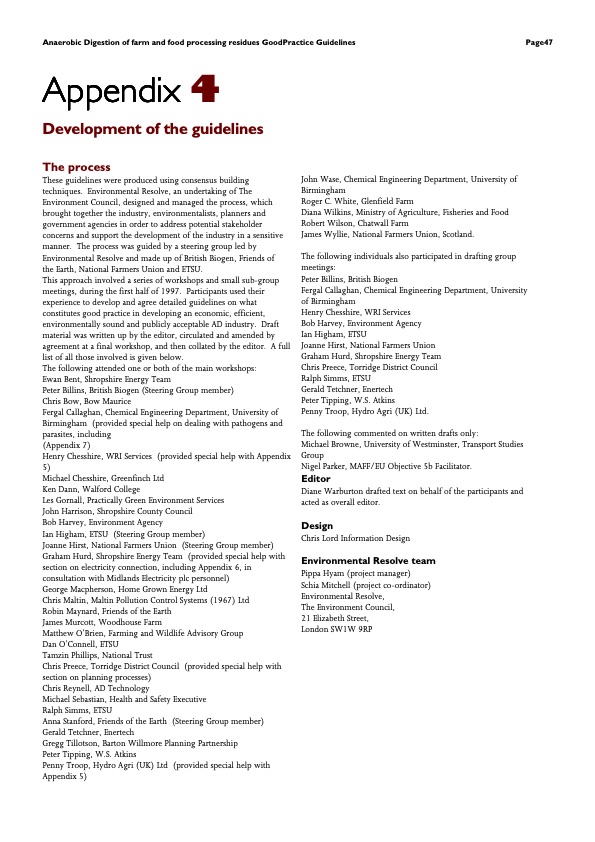
PDF Publication Title:
Text from PDF Page: 049
Anaerobic Digestion of farm and food processing residues GoodPractice Guidelines Page47 Appendix 4 Development of the guidelines The process These guidelines were produced using consensus building techniques. Environmental Resolve, an undertaking of The Environment Council, designed and managed the process, which brought together the industry, environmentalists, planners and government agencies in order to address potential stakeholder concerns and support the development of the industry in a sensitive manner. The process was guided by a steering group led by Environmental Resolve and made up of British Biogen, Friends of the Earth, National Farmers Union and ETSU. This approach involved a series of workshops and small sub-group meetings, during the first half of 1997. Participants used their experience to develop and agree detailed guidelines on what constitutes good practice in developing an economic, efficient, environmentally sound and publicly acceptable AD industry. Draft material was written up by the editor, circulated and amended by agreement at a final workshop, and then collated by the editor. A full list of all those involved is given below. The following attended one or both of the main workshops: Ewan Bent, Shropshire Energy Team Peter Billins, British Biogen (Steering Group member) Chris Bow, Bow Maurice Fergal Callaghan, Chemical Engineering Department, University of Birmingham (provided special help on dealing with pathogens and parasites, including (Appendix 7) Henry Chesshire, WRI Services (provided special help with Appendix 5) Michael Chesshire, Greenfinch Ltd Ken Dann, Walford College Les Gornall, Practically Green Environment Services John Harrison, Shropshire County Council Bob Harvey, Environment Agency Ian Higham, ETSU (Steering Group member) Joanne Hirst, National Farmers Union (Steering Group member) Graham Hurd, Shropshire Energy Team (provided special help with section on electricity connection, including Appendix 6, in consultation with Midlands Electricity plc personnel) George Macpherson, Home Grown Energy Ltd Chris Maltin, Maltin Pollution Control Systems (1967) Ltd Robin Maynard, Friends of the Earth James Murcott, Woodhouse Farm Matthew O’Brien, Farming and Wildlife Advisory Group Dan O’Connell, ETSU Tamzin Phillips, National Trust Chris Preece, Torridge District Council (provided special help with section on planning processes) Chris Reynell, AD Technology Michael Sebastian, Health and Safety Executive Ralph Simms, ETSU Anna Stanford, Friends of the Earth (Steering Group member) Gerald Tetchner, Enertech Gregg Tillotson, Barton Willmore Planning Partnership Peter Tipping, W.S. Atkins Penny Troop, Hydro Agri (UK) Ltd (provided special help with Appendix 5) John Wase, Chemical Engineering Department, University of Birmingham Roger C. White, Glenfield Farm Diana Wilkins, Ministry of Agriculture, Fisheries and Food Robert Wilson, Chatwall Farm James Wyllie, National Farmers Union, Scotland. The following individuals also participated in drafting group meetings: Peter Billins, British Biogen Fergal Callaghan, Chemical Engineering Department, University of Birmingham Henry Chesshire, WRI Services Bob Harvey, Environment Agency Ian Higham, ETSU Joanne Hirst, National Farmers Union Graham Hurd, Shropshire Energy Team Chris Preece, Torridge District Council Ralph Simms, ETSU Gerald Tetchner, Enertech Peter Tipping, W.S. Atkins Penny Troop, Hydro Agri (UK) Ltd. The following commented on written drafts only: Michael Browne, University of Westminster, Transport Studies Group Nigel Parker, MAFF/EU Objective 5b Facilitator. Editor Diane Warburton drafted text on behalf of the participants and acted as overall editor. Design Chris Lord Information Design Environmental Resolve team Pippa Hyam (project manager) Schia Mitchell (project co-ordinator) Environmental Resolve, The Environment Council, 21 Elizabeth Street, London SW1W 9RPPDF Image | Anaerobic Digestion Of farm and food Processing residues The development of a sustainable industry

PDF Search Title:
Anaerobic Digestion Of farm and food Processing residues The development of a sustainable industryOriginal File Name Searched:
biogas10.pdfDIY PDF Search: Google It | Yahoo | Bing
Capstone Turbine and Microturbine: Capstone microturbines used and new surplus for sale listing More Info
Consulting and Strategy Services: Need help with Capstone Turbine, sizing systems, applications, or renewable energy strategy, we are here to assist More Info
Container Lumber Dry Kiln: Since 1991 developing and innovating dry kilns using standard shipping containers More Info
Supercritical CO2 Lumber Dry Kiln: Compact fast drying in 3 days or less for small amounts of wood and lumber drying More Info
BitCoin Mining: Bitcoin Mining and Cryptocurrency... More Info
Publications: Capstone Turbine publications for microturbine and distributed energy More Info
FileMaker Software for Renewable Energy Developing database software for the renewable energy industry More Info
CO2 Gas to Liquids On-Demand Production Cart Developing a supercritical CO2 to alcohol on-demand production system (via Nafion reverse fuel cell) More Info
Stranded Gas for low cost power Bitcoin Mining Using stranded gas for generators may provide breakthrough low power costs for cryptocurrency miners. More Info
| CONTACT TEL: 608-238-6001 Email: greg@globalmicroturbine.com | RSS | AMP |